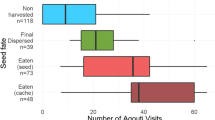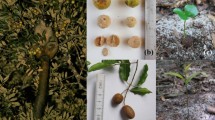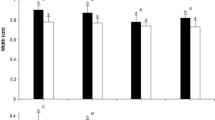Abstract
We studied the effect of seed density on seed predation by following the fate of bat-dispersed Dipteryx micrantha (Leguminosae) seeds deposited under bat feeding roosts. The study was conducted in Cocha Cashu biological station, Amazonian Peru, during the fruiting period of Dipteryx. Predation of Dipteryx seeds in the area is mainly by large to medium-sized rodents. Seed deposits beneath bat feeding roosts were monitored for a 13-week period in an 18-ha study area. A total of 210 seed deposits were found, and on average, seed predators encountered 22% of them during any one week. About one-third of the seed deposits escaped predation, and those deposits that had relatively few seeds were more likely to go unnoticed by rodents than were deposits with many seeds. The mean seed destruction rate was 8% per week; deposits with many seeds tended to lose a smaller proportion of their seeds to seed predators than did deposits with few seeds. Regression tests for the weekly data showed that, at the beginning of the observation period, seed predation was not density-dependent. Later, when the total seed crop beneath roosts was high, the number of seeds predated per deposit was positively density-dependent, while the proportion of seeds predated was negatively density-dependent, indicating predator satiation. Seed deposits that had been visited by seed predators once had a higher probability of being revisited the week after, especially if they contained many seeds when first encountered. This indicates that the foraging behavior of rodents may be affected by their remembering the location of seed-rich patches.




Similar content being viewed by others
References
Adler GH (1995) Fruit and seed exploitation by Central American spiny rats, Proechimys semispinosus. Stud Neotrop Fauna Environ 30:237–244
Adler GH, Kestell DW (1998) Fates of neotropical tree seeds influenced by spiny rats (Proechimys semispinosus). Biotropica 30:677–681
Alcántara JM, Rey PJ, Sánchez-Lafuente AM, Valera F (2000) Early effects of rodent post-dispersal seed predation on the outcome of the plant–seed disperser interaction. Oikos 88:362–370
Augsburger CK, Kitajima K (1992) Experimental studies of seedling recruitment from contrasting seed distributions. Ecology 73:1270–1284
Bonaccorso FJ, Glanz WE, Sandford CM (1980) Feeding assemblages of mammals at fruiting Dipteryx panamensis (Papilionaceae) trees in Panama: seed predation, dispersal, and parasitism. Rev Biol Trop 28:61–72
Brewer SW, Webb MAH (2001) Ignorant seed predators and factors affecting the seed survival of a tropical palm. Oikos 93:32–41
Burkey TV (1994) Tropical tree species diversity: a test of the Janzen-Connell model. Oecologia 97:533–540
Cabin RJ, Marshall DL, Mitchell RJ (2000) The demographic role of soil seed banks. II. Investigations of the fate of experimental seeds of the desert mustard Lesquerella fendleri. J Ecol 88:293–302
Cintra R (1997a) A test of the Janzen-Connell model with two common tree species in Amazonian forest. J Trop Ecol 13:641–658
Cintra R (1997b) Leaf litter effects on seed and seedling predation on the palm Astrocaryum murumuru and the legume tree Dipteryx micrantha in Amazonian forest. J Trop Ecol 13:709–725
Cintra R, Horna V (1997) Seed and seedling survival of the palm Astrocaryum murumuru and the legume tree Dipteryx micrantha in gaps in Amazonian forest. J Trop Ecol 13:257–277
Clark DA, Clark DB (1984) Spacing dynamics of a tropical rain forest tree: evaluation of the Janzen-Connell model. Am Nat 124:769–788
Connell JH (1971) On the role of natural enemies in preventing competitive exclusion in some marine animals and in rain forest trees. In: den Boer PJ, Gradwell DR (eds) Dynamics of populations. Centre for Agricultural Publishing and Documentation, Wageningen, pp 298–310
Cummings CL, Alexander HM (2002) Population ecology of wild sunflowers: effects of seed density and post-dispersal vertebrate seed predators. Oecologia 130:274–280
De Steven D, Putz FE (1984) Impact of mammals on early recruitment of a tropical canopy tree, Dipteryx panamensis , in Panama. Oikos 43:207–216
Edwards GR, Crawley MJ (1999) Rodent seed predation and seedling recruitment in mesic grassland. Oecologia 118:288–296
Forget PM (1992) Seed removal and seed fate in Gustavia superba (Lecythidaceae). Biotropica 24:408–414
Forget PM (1993) Post-dispersal predation and scatterhoarding of Dipteryx panamensis (Papilionaceae) seeds by rodents in Panama. Oecologia 94:255–261
Forget PM, Kitajima K, Foster RB (1999) Pre- and post-dispersal seed predation in Tachigali versicolor (Caesalpiniaceae): effects of timing of fruiting and variation among trees. J Trop Ecol 15:61–81
Forget PM, MilleronT, Feer F, Henry O, Dubost G (2000) Effects of dispersal pattern and mammalian herbivores on seedling recruitment for Virola michelii (Myristicaceae) in French Guiana. Biotropica 32:452–462
Gentry AH (ed) (1990) Four neotropical rainforests. Yale University Press, New Haven
Glanz WD (1982) The terrestrial mammal fauna of Barro Colorado Island: censuses and long-term changes. In: Leigh EG Jr, Rand AS, Windsor DM (eds) The ecology of a tropical forest: seasonal rhythms and long-term changes. Smithsonian, Washington D.C., pp 455–468
Gryj EO, Domínguez CA (1996) Fruit removal and postdispersal survivorship in the tropical dry forest shrub Erythroxylum havanense: ecological and evolutionary implications. Oecologia 108:368–374
Hammond DS, Brown V K (1998) Disturbance, phenology and life-history characteristics: factors influencing distance/density-dependent attack on tropical seeds and seedlings. In: Newbery DM, Prins HHT, Brown ND (eds) Dynamics of tropical communities. Blackwell Science, Oxford, pp 51–78
Hammond DS, Brown V, Zagt R (1999) Spatial and temporal patterns of seed attack and germination in a large-seeded neotropical tree species. Oecologia 119:208–218
Hulme PE (1994) Post-dispersal seed predation in grassland: Its magnitude and sources of variation. J Ecol 82:645–652
Hulme PE (1997) Post-dispersal seed predation and the establishment of vertebrate dispersed plants in Mediterranean scrublands. Oecologia 111:91–98
Hulme PE, Hunt ME (1999) Rodent post-dispersal seed predation in deciduous woodland: predator response to absolute and relative abundance of prey. J Anim Ecol 68:417–428
Janson CH, Emmons LH (1990) Ecological structure of the nonflying mammal community at Cocha Cashu Biological Station, Manu National Park, Peru. In: Gentry AH (ed) Four neotropical rain forests. Yale University Press, New Haven, pp 314–338
Janzen DH (1970) Herbivores and the number of tree species in tropical forest. Am Nat 104:501–528
Legendre P, Legendre L 1998. Numerical ecology, 2nd English edn. Develop Environ Model 20:1–853
Manson RH, Stiles EW (1998) Links between microhabitat preferences and seed predation by small mammals in old fields. Oikos 82:37–50
Manson RH, Ostfeld RS, Canham CD (1998) The effects of tree seed and seedling density on predation rates by rodents in old fields. Ecoscience 5:183–190
Myster RW, Pickett STA (1993) Effects of litter, distance, density and vegetation patch type on postdispersal tree seed predation in old fields. Oikos 66:381–388
Palmeirim J, Etheridge K (1985) The influence of man-made trails on foraging by tropical frugivorous bats. Biotropica 17:82–83
Romo MC (1996) Seasonal variation in fruit consumption and seed dispersal by canopy bats (Artibeus spp.) in a lowland forest in Peru. Vida Silvestre Neotrop 5:110–119
Sánchez-Cordero V, Martínez-Gallardo R (1998) Postdispersal fruit and seed removal by forest-dwelling rodents in a lowland rain forest in Mexico. J Trop Ecol 14:139–151
Smythe, N, Glanz WE, Leigh EG Jr (1982) Population regulation in some terrestrial frugivores. In: Leigh EG Jr, Rand AS, Windsor DM (eds) The ecology of a tropical forest: seasonal rhythms and long-term changes. Smithsonian, Washington, D.C., pp 227–238
Terborgh J, Wright SJ (1994) Effects of mammalian herbivores on plant recruitment in two neotropical forests. Ecology 75:1829–1833
Vander Wall SB (1990) Food hoarding in animals. University of Chicago Press, Chicago, Illinois
Willson MF, Whelan CJ (1990) Variation in post-dispersal survival of vertebrate-dispersed seeds: effects of density, habitat, location, season and species. Oikos 57:191–198
Acknowledgements
We thank the Peruvian National Directorate for Protected Areas for the permit to conduct research in a pristine area where the tree and seed predator communities are still in natural conditions. We are grateful to John Terborgh and Mercedes Foster for practical help at the Cocha Cashu station, and to Ricardo Sanchez and Alexi Herrera for their dedicated assistance in the field. The research was funded by the World Wildlife Fund grant to Cocha Cashu, the Academy of Finland, and the Turku University Foundation.
Author information
Authors and Affiliations
Corresponding author
Rights and permissions
About this article
Cite this article
Romo, M., Tuomisto, H. & Loiselle, B.A. On the density-dependence of seed predation in Dipteryx micrantha, a bat-dispersed rain forest tree. Oecologia 140, 76–85 (2004). https://doi.org/10.1007/s00442-004-1502-x
Received:
Accepted:
Published:
Issue Date:
DOI: https://doi.org/10.1007/s00442-004-1502-x




